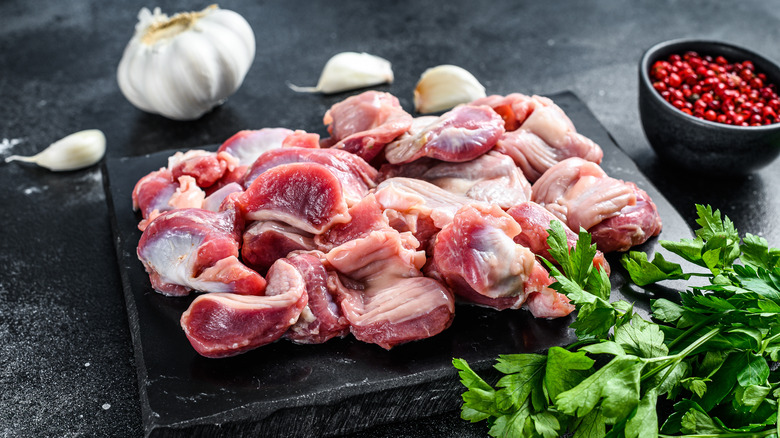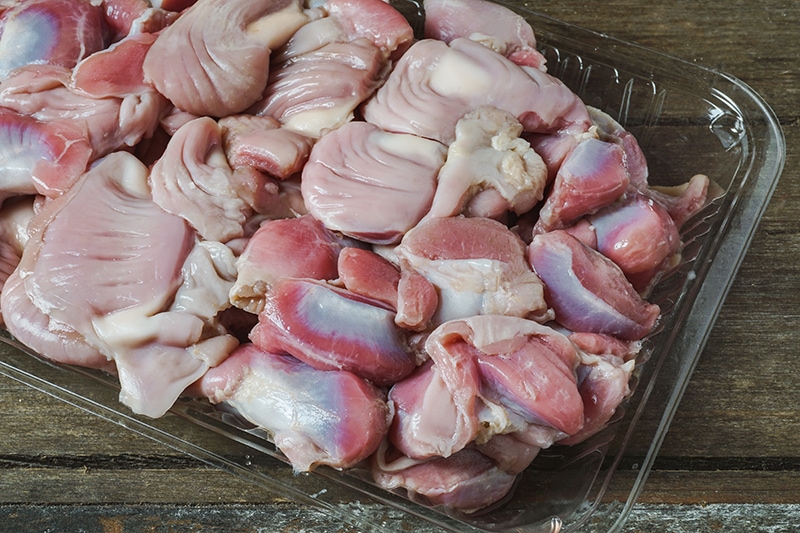Chicken gizzards are often overlooked at the grocery store, yet they are one of the most nutrient-dense, affordable, and versatile cuts of poultry available. Known as part of the “offal” or organ meat category, gizzards are highly valued in various global cuisines, including Filipino, Southern U.S., Latin American, and Asian cooking traditions.
Despite their low price tag, chicken gizzards offer a remarkable nutritional profile. Let’s explore their health benefits, how to prepare them properly, and important dietary considerations—backed by current nutritional science and verified expert sources.
What Are Chicken Gizzards?
A gizzard is a muscular part of a bird’s digestive system that grinds food. Since birds don’t have teeth, they rely on this specialized organ to help break down seeds and grains with the help of grit (tiny stones they consume).
When properly prepared, chicken gizzards have a rich, meaty flavor and a dense, slightly chewy texture that becomes tender with the right cooking techniques.
Nutritional Benefits of Chicken Gizzards
According to the U.S. Department of Agriculture (USDA), a 3.5-ounce (100g) serving of cooked chicken gizzards contains:
- 94 calories
- 18 grams of protein
- 2 grams of fat
- 0 grams of carbohydrates
- 2.5 milligrams of iron (14% of the RDA)
- 0.7 micrograms of vitamin B12 (30% of the RDA)
- Niacin (Vitamin B3), Riboflavin, Selenium, Zinc, and Phosphorus
These nutritional values show why gizzards are considered a high-protein, low-fat option suitable for people focused on muscle repair, energy production, and immune support.

Key Nutrients and Their Benefits:
- Protein: Helps build and repair tissues, supports muscle growth, and keeps you feeling full.
- Vitamin B12: Essential for neurological function and red blood cell formation.
- Iron: Critical for oxygen transport in the blood, especially important for individuals at risk of iron-deficiency anemia.
- Selenium and Zinc: Support immune health, antioxidant protection, and wound healing.
- Choline: Important for brain development and liver function, especially during pregnancy.
Are Chicken Gizzards Healthy?
When consumed in moderation, chicken gizzards are a healthy protein source. As noted by Medical News Today, organ meats like gizzards are lower in fat than red meats, yet higher in important micronutrients.
However, gizzards do contain dietary cholesterol (about 240 mg per 3.5 oz serving). While this was once thought to impact heart disease risk directly, current guidelines from the Harvard School of Public Health suggest that saturated fat and trans fats play a more significant role in raising blood cholesterol levels. Since gizzards contain less than 1 gram of saturated fat per serving, they are generally considered safe for heart health when eaten as part of a balanced diet.

Considerations for Certain Health Conditions
1. Cholesterol Concerns
People with elevated cholesterol should monitor their total intake of organ meats. Although gizzards are low in saturated fat, they are high in cholesterol and may need to be limited depending on individual dietary goals.
2. Gout
Gizzards, like many organ meats, contain purines, which can increase uric acid levels and may trigger gout flare-ups in susceptible individuals, according to Cleveland Clinic recommendations. Those with a history of gout should consume gizzards infrequently.
3. Antibiotic Use in Poultry
As reported by The Guardian, industrial poultry farming often includes the use of antibiotics to prevent disease. Repeated exposure to antibiotic residues can potentially contribute to antibiotic resistance. To reduce this risk, consider choosing certified organic chicken gizzards, which are raised without antibiotics.

How to Cook Chicken Gizzards (Properly)
The key to enjoying gizzards is tenderizing them properly. They have a naturally firm texture that can be transformed into something soft and savory when cooked correctly.
1. Boil and Simmer
Start by boiling gizzards for 30–45 minutes in salted water with aromatics like garlic, onion, and bay leaf. This step softens the meat and infuses it with flavor. After boiling, you can add them to soups, stews, or rice dishes.
2. Deep-Fry (in moderation)
For a crispy treat, dredge pre-boiled gizzards in seasoned flour and pan-fry or deep-fry them until golden brown. Best enjoyed occasionally as part of a balanced diet.
3. Sauté or Stir-Fry
Slice boiled gizzards and sauté with garlic, bell peppers, soy sauce, and chili flakes for a quick high-protein stir-fry.
4. Slow-Cooker or Braise
Add raw gizzards to a slow cooker with broth, vegetables, and herbs. Let them simmer for 4–6 hours for fall-apart tenderness.
5. Grill for a Smoky Finish
Marinate in lemon juice, soy sauce, and herbs, then grill over medium heat until charred. Serve with roasted vegetables or a salad.

Popular Chicken Gizzard Dishes Around the World
- Filipino Gizzard Adobo: Gizzards stewed in vinegar, soy sauce, and garlic.
- Brazilian Moela: Simmered in tomato and onion sauce, often served with rice.
- Southern Fried Gizzards (USA): Seasoned, deep-fried, and served with hot sauce.
- Gizzard Soup (West Africa): A hearty, spicy broth featuring gizzards and root vegetables.
- Grilled Gizzard Skewers (Japan/Yakitori): Charcoal-grilled with tare sauce or salt.
Budget-Friendly and Sustainable
As food prices continue to rise globally, chicken gizzards remain one of the most cost-effective protein sources on the market. In the United States, gizzards are often available for under $2 per pound. They are also more sustainable than many red meats due to the lower environmental impact of poultry farming.
Eating gizzards also promotes nose-to-tail consumption, reducing food waste and encouraging ethical meat-eating habits.

Final Thoughts: Are Chicken Gizzards Right for You?
Chicken gizzards are nutrient-rich, affordable, and delicious when cooked well. They provide essential nutrients like protein, iron, B vitamins, and minerals that support energy, immunity, and muscle health.
While not ideal for everyone—especially those with gout or severe cholesterol concerns—gizzards can be enjoyed safely in moderation by most people. For the best quality and fewer health risks, opt for organic or antibiotic-free options when available.
So next time you’re at the grocery store or farmer’s market, consider adding chicken gizzards to your cart. With the right recipe, you might just discover your new favorite dish.
Verified and Reputable Sources:
- USDA FoodData Central – Chicken Gizzards
- Harvard T.H. Chan School of Public Health – Cholesterol and Heart Health
- Medical News Today – Organ Meats: Nutrition and Safety
- Cleveland Clinic – Gout and Diet
- The Guardian – Antibiotic Resistance and Poultry



